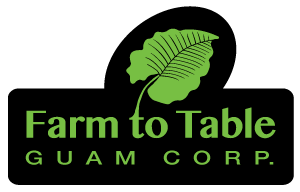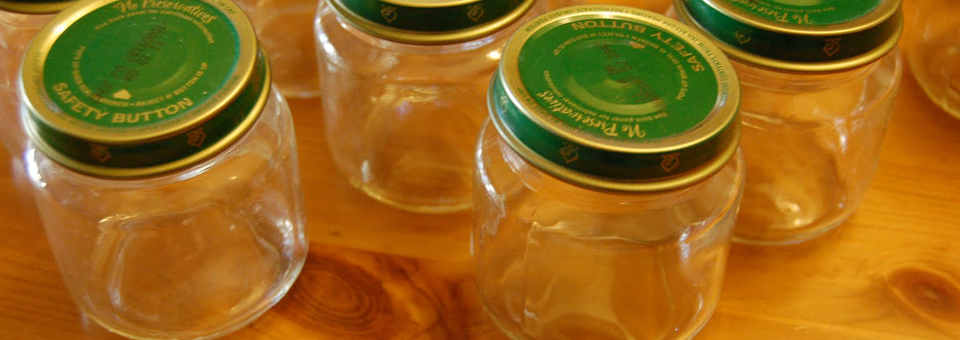
By Rita Salisbury, Project Administrative Assistant

Do-it-yourself baby food — I know; it sounds back yard, sketchy, and very expensive. I cannot deny and feel I must disclose that the do-it-yourself baby food process is labor-intensive and requires quite a bit of planning. However, you won’t need to buy a fancy food-processing unit or outfit your kitchen according to Gerber standards. Making baby food for your child doesn’t need to break the bank. And you will have the satisfaction of knowing that the food your baby eats will be fresh, nutritious, and virtually chemical free!
First, I’d like to provide a little background on my journey to do-it-yourself baby food. I became a mommy in 1995 at the age of 23. We were living in Hawaii, where a healthy and natural lifestyle was not only epitomized by the tan, strong bodies on the beach and in the water, but also supported by the local economy. Locally grown produce was readily available in every grocery retailer from the mom and pop store down the block, to the nearest Safeway or Foodland outlet. Through the encouragement to nurse our daughter by my ob-gyn, as well as the Lamaze instructor who led our birthing classes, I was inspired to provide the healthiest nutrition for the newest member of our growing family.
Why do it yourself?
I did some research on what went into the production of pre-made,  store bought baby food. What I found was a bit disturbing.
store bought baby food. What I found was a bit disturbing.
Trace amounts of the chemicals used to protect and grow the fruits and vegetables used in baby foods can find their way into the final product.
Additionally, in order for baby food to survive on the shelf, steps are taken to prevent spoilage. These steps included pasteurization (to kill the bacteria responsible for spoilage). However, pasteurization also destroys some of the nutrients present in the veggies and fruits. My research turned to organic alternatives, which proved to be a bit expensive for our wallets. After hours of perusing the baby food shelves of our local grocery store, I picked up a jar of organic sweet potatoes and scanned the ingredient list: sweet potatoes. That was it. It dawned on me that I could make this for our daughter. Mad scientist mama was born.
Where to Begin
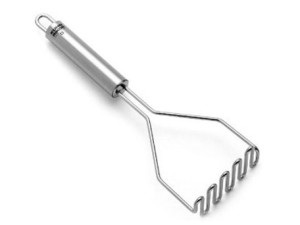
I was a bit concerned that my experimentation would do more harm than good to our baby, so I asked our pediatrician what her opinion on the matter was. After discussing the proper age to introduce solid foods, watching for allergies, and encouragement to use organically grown produce, my worries were all but gone.
I decided to start with bananas, sweet potatoes, and baby carrots, as they were readily available, sweet, and easily prepared. Preparation involved cutting and mashing the bananas, cutting and steaming the carrots, and cutting and boiling the sweet potatoes until they were very soft to the touch. After cooling, I mashed the produce to a very smooth consistency. Hand mills and grinders were encouraged to ensure that the food is processed enough to prevent choking. But, I was able to do so using a masher and a fork. I kept the prepared food in sterilized jars in the fridge.
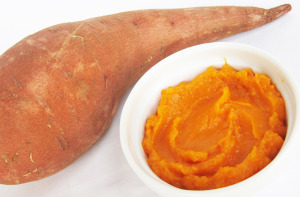 For the first feeding, I added a small amount of the mashed bananas to some baby rice cereal and some warm breast milk to thin the mixture. Judging by the fact that more of the food ended up in her mouth than on her body, I realized that she liked it. Success! I was hooked.
For the first feeding, I added a small amount of the mashed bananas to some baby rice cereal and some warm breast milk to thin the mixture. Judging by the fact that more of the food ended up in her mouth than on her body, I realized that she liked it. Success! I was hooked.
From that moment on, I made most of our daughter’s baby food, until her teeth came in and she was able to chew like a pro.
I did the same for our three bundles of joy that came later, trading my masher for a hand blender and discovering that freezing the food in ice cube trays provided perfect portion sized cubes that could be thawed and warmed when necessary for feedings.
Is it worth it?
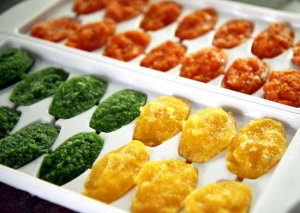 In conclusion, my experience taught me that the do-it-yourself baby food process entails a great deal of planning and prep work. But in the end, I found the greatest satisfaction in the fact that I knew exactly what was in the food I was giving our baby, and that it was made in a way that preserved the nutritional content of the produce. Please remember to share your plans to make your own baby food with your pediatrician. You will need to have professional guidance when choosing the right food for the right stage of your baby’s development. Additionally, your pediatrician will be the greatest source of information regarding any issues, like potential allergies, that may affect your baby’s ability to ingest the food you will be preparing.
In conclusion, my experience taught me that the do-it-yourself baby food process entails a great deal of planning and prep work. But in the end, I found the greatest satisfaction in the fact that I knew exactly what was in the food I was giving our baby, and that it was made in a way that preserved the nutritional content of the produce. Please remember to share your plans to make your own baby food with your pediatrician. You will need to have professional guidance when choosing the right food for the right stage of your baby’s development. Additionally, your pediatrician will be the greatest source of information regarding any issues, like potential allergies, that may affect your baby’s ability to ingest the food you will be preparing.
Using Local Produce from Guam
By buying local, you not only know where your food is coming from, but you are supporting Guam’s local farmers and helping with the economy. Below is a list of common fruits and vegetables typically found on Guam, along with a few links of tasty recipes to get you started. Find out where you can find local produce.
- Avocado
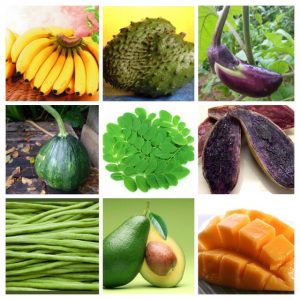
- Banana
- Chaya (similar to spinach)
- Dagu (yams)
- Eggplant
- Jackfruit
- Long Beans
- Mango
- Moringa (Malunggay)
- Sweet Potato
- Squash
- Pumpkin
- Papaya
- Soursop (Graviola, Guanabana)
- Watermelon
Tips to Remember
- Babies 4-6 months old can begin to have pureed foods
- Oranges, grapefruit and strawberries are highly acidic and may cause painful diaper rash. You may want to wait closer to the infant is almost one.
- Watch fruit intake, as some are high in sugar.
- Don’t serve within the first year:
- Berries (except blueberries)
- Citrus (orange, lemon, pineapple, etc.)
- Tomatoes
- Some foods don’t need to be cooked, such as ripe fruits (banana, peaches, melon, avocado etc). For foods that need softening, you can steam, boil, roast, poach, bake, braise, simmer.
- Be creative-mix and match fruits and vegetables!
- You may need to add liquid when blending to achieve the right consistency (which will depend on the baby’s development). Breast milk and formula are recommended, but you can also use the water that the veggies were cooked in, coconut milk and homemade chicken stock.
- Very occasionally, eggplant may be on the bitter side, which can irritate the lining of the stomach, resulting in an upset tummy. Have a quick taste before serving.
- Modern varieties of eggplant generally taste much milder than they used to.
- Be sure to consult with your physician about changing your babies diet.
- Here are some helpful sites that provide recipes and information regarding the advantages and disadvantages of do-it-yourself baby food:
Have you tried making your own baby food? Share your experience with us!
Content and Photo Source: healthyeating.sfgate.com, coconutxoxo.blogspot.com, nutritionistreviews.com, parentinghealthybabies.com, itsybee.com, homemade-baby-food-recipes.com, parents.com, authoritynutrition.com, shopthepig.com, grubstreet.com, treesforlife.org
